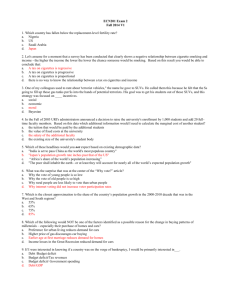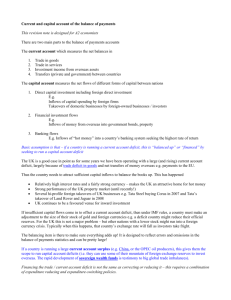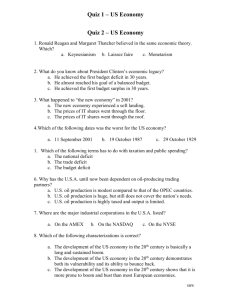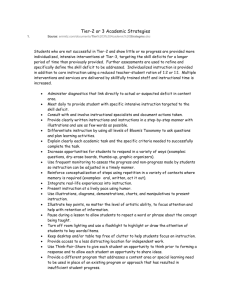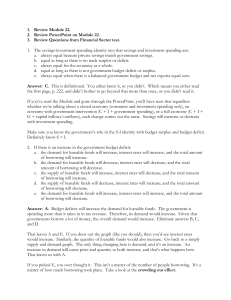National Income Accounting and the Balance of Payments The
advertisement
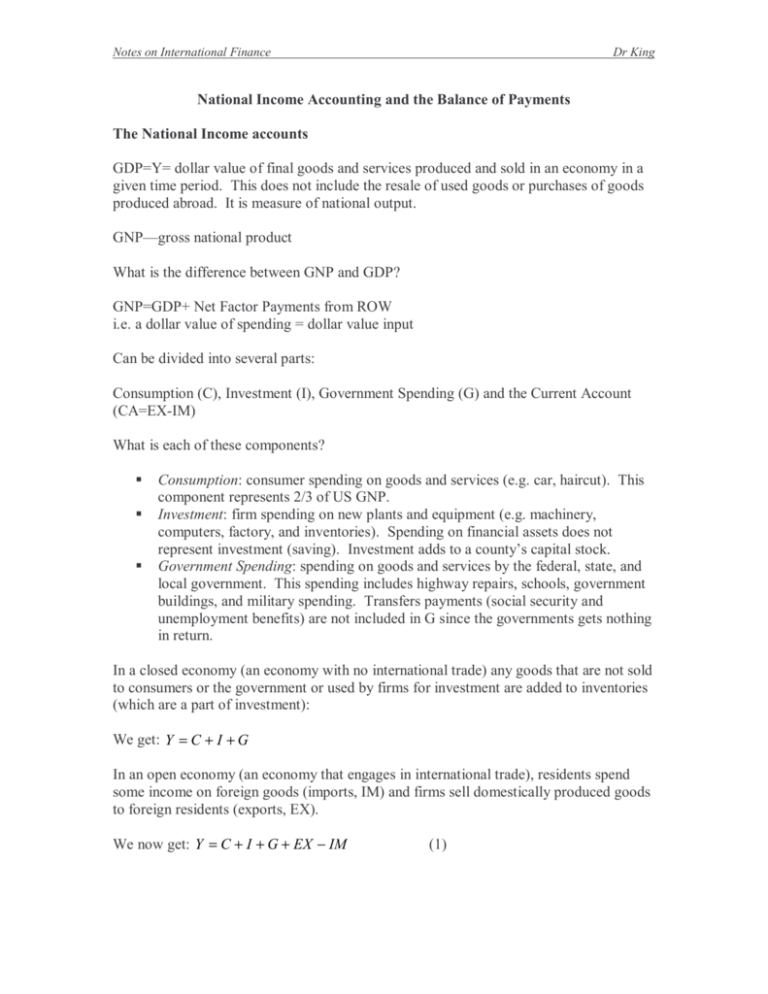
Notes on International Finance
Dr King
National Income Accounting and the Balance of Payments
The National Income accounts
GDP=Y= dollar value of final goods and services produced and sold in an economy in a
given time period. This does not include the resale of used goods or purchases of goods
produced abroad. It is measure of national output.
GNP—gross national product
What is the difference between GNP and GDP?
GNP=GDP+ Net Factor Payments from ROW
i.e. a dollar value of spending = dollar value input
Can be divided into several parts:
Consumption (C), Investment (I), Government Spending (G) and the Current Account
(CA=EX-IM)
What is each of these components?
Consumption: consumer spending on goods and services (e.g. car, haircut). This
component represents 2/3 of US GNP.
Investment: firm spending on new plants and equipment (e.g. machinery,
computers, factory, and inventories). Spending on financial assets does not
represent investment (saving). Investment adds to a county’s capital stock.
Government Spending: spending on goods and services by the federal, state, and
local government. This spending includes highway repairs, schools, government
buildings, and military spending. Transfers payments (social security and
unemployment benefits) are not included in G since the governments gets nothing
in return.
In a closed economy (an economy with no international trade) any goods that are not sold
to consumers or the government or used by firms for investment are added to inventories
(which are a part of investment):
We get: Y = C + I + G
In an open economy (an economy that engages in international trade), residents spend
some income on foreign goods (imports, IM) and firms sell domestically produced goods
to foreign residents (exports, EX).
We now get: Y = C + I + G + EX − IM
(1)
Notes on International Finance
Dr King
Current Account: The CA shows the difference between exports and imports of
goods and services (and net unilateral transfers). Note: the trade balance (TB=NX
without unilateral transfers). It is a prime point of interaction between
countries—the focus of this class.
When:
EX > IM → CA > 0 → surplus
EX < IM → CA < 0 → deficit
The CA and Foreign Indebtness
A country’s current account balance equals the change in a country’s foreign net wealth.
Why?
A country with a CA surplus shows that it is earning more from EX than IM.
A country with a CA deficit shows that it is earning less from EX than IM.
A country finances its deficit by borrowing from the surplus country. How? The deficit
country issues an IOU (which will be redeemed later).
Let’s rearrange equation (1):
Y = C + I + G + EX
−4
IM
142
3
CA
Y − (C + I + G ) = CA
1. If Y > (C + I + G ) ⇒ CA > 0
2. If Y < (C + I + G ) ⇒ CA < 0
1. If a country is spending less than income (production), it must be running a
current account surplus.
2. If a country is spending more than income (production), it must be running a
current account deficit.
How does the country finance this excess spending? It borrows.
Q: what do we do when we spend more than we earn?
A: we use a credit card (borrow money that has to be paid later).
The current account shows the amount of international lending or borrowing. Essentially,
a CA deficit is trading current consumption for future consumption. A current account
surplus is like giving up current consumption in exchange for future consumption
(Intertemporal Consumption).
Notes on International Finance
Dr King
If we are borrowing money, then our net wealth must be falling (debts are increasing).
For a country, it is the same. If our net foreign wealth is falling, our net foreign debt is
rising.
CA and Saving
Recall from intro macro, in a closed economy, national savings equals investment:
Private saving: S p = Y − C − T
Public Saving: S g = T − G
Total Saving: S = S g + S p = Y − C − T + T − G
S =Y −C −G = I
(2)
In a open economy, we have:
S = Y − C − G = I + CA
S − I = CA
(3)
1. If savings is greater than investment, we must be lending money to the rest of the
world (ROW). The ROW is borrowing money to increase their capital stock.
2. If savings is less than investment, we must be borrowing money from the rest of
the world (ROW). Domestic country is borrowing money to increase our capital
stock.
S > I ⇒ CA > 0 → can loan to others
S < I ⇒ CA < 0 → must borrow from others
Why might I>S? Building up capital. Example, going to collegeÆ get in debtÆ
building up human capitalÆget higher income in futureÆthen pay off debt. Is this
necessarily a bad thing?
Numerical Example:
Y = 900
C = 500
I = 200
G = 200
T = 100
S = 900 − 500 − 200 = 200 = I
Pg = T − G = 100 − 200 = −100
Pp = Y − T − C = 900 − 100 − 500 = 300
Notes on International Finance
Dr King
So, private savings are spent on investment (200) and financing the government deficit
(100) by buying bonds or other government debt instruments (T-bills).
Now, lets add the CA:
EX = 0
IM = 200
S = 900 − 500 − 200 = 200 = I
Pg = T − G = 100 − 200 = −100
Pp = Y − T − C = 900 − 100 − 500 = 300
S = Y − C − G = CA + I
All domestic savings are allocated to I and gov’t deficit. The only way to finance this
import spending is from borrowing abroad. Foreigners buy bonds, stocks, etc. This is a
cap[ital inflow into the US and is a KA credit. Obviously, the best way is to sell exports
to ROW (EX=200).
The Twin Deficits: does the government budget deficit worsen the CA deficit? [Show
graph.]
During the 1980’s, US ran a huge CA deficit while Japan ran a huge CA surplus.
The US was importing many gods from Japan while Japan was importing very
little from the US—Japan imposed non-tariff barriers—led to a trade war.
Simultaneously, President Reagan’s administration cut taxes and increased
government spending (on military). Budget deficit increased. The worsening CA
deficit was blamed on tax cuts causing increased incentives to I.
Let go back to equation (2).
S = Sg + S p = Y − C − T + T − G
S + S p = I + CA
{g
T −G
CA = S p − I − (G − T )
G − T = budget deficit
Looking at the data, there does appear to be a strong correlation. But is this correlation
coincidence? Researchers are still investigating this issue today.
Notes on International Finance
Dr King
The Balance of Payments
The balance of payments accounts shows a detailed record of a country’s economic
transactions with the ROW during an accounting period: i.e. its payments to foreigners
and receipts from foreigners.
A payment to foreigners is a debit (-).
A receipt from foreigners is a credit (+).
The (Balance of Payments) BOP
Credit
Debit
Current Account
(1) Export of goods
(3) Export of Non Factor services
(5) Export of Factor services
(7) Unilateral Transfers to US
(2) Imports
(4) Import of Non Factor services
(6) Import of Factor services
(8) Unilateral Transfers from US
Balance=(1)-(2)+[(3)-(3')4)]+[(5)-(6)]+[(7)-(8)]
Capital Account
(9) ST Capital Inflow (<1 yr)
(Foriegn assets held in US)
(11) LT Capital Inflow
(13) FDI into US
(10) ST Capital I Outflow (<1 yr)
(US assets held abroad)
(12) LT Capital Outflow
(14) FDI in foreign country by US firms
(15) Official Reserve Assets
(16) Official Reserve Assets
(Fall in US CB holding of foreign assets) (Fall in Foriegn CB holding of US assets)
Fed gets $'s in exchange for F currency
(15) Official Reserve Assets
(16) Official Reserve Assets
(Rise in Foriegn CB holding of US assets)(Rise in US CB holding of foriegn assets)
They send $'s to US
Balance=(49)-(10)+[(11)-(12)]+[(13)-(14)]+[(14)-(16)]
Statistical Discrepancy
The balance of payments implies that the CA+KA=0
Current Account
Exports of goods and services (1) and (3): includes goods and services. Examples
are Jeep, Levis Jeans, travel and tourism.
Notes on International Finance
Dr King
Exports of factor (land, labor and capital) services (5): income from factor
services (residing abroad). Examples are a US Lawyer working in England, or
dividends from Ford UK. Also includes returns or investment income.
Imports of goods and services (2) and (4): includes goods and services. Examples
are French cheeses, Shetland sweater, or Mercedes, travel and tourism.
Imports of factor services (6): income from factor services (residing in US).
Examples are a British investment banker working in NY, or dividends from
BMW (German Auto).
Unilateral Transfers (7) and (8): these are gifts. Examples are foreign aid or gifts
such as Mexican/Cuban workers in the US sending money home to dependents,
retirement pensions. The US usually records a deficit on this item with the
exception of 1991 when countries sent money to the US to pay for the war in the
Mideast.
If we are usually running a current account deficit, how is the deficit financed? We
borrow money from the ROW to pay for the deficit. That means money must be flowing
into the US. Large current account deficits imply large capital account surpluses.
Capital Account
Capital Inflow (9) and (11): includes short and long term capital inflow. When
the US borrows from abroad. Examples are a UK resident buying a US Treasury
bond. This item also includes bank deposits in the US by foreign residents.
Capital Outflow (10) and (12): includes short and long term capital inflow. When
the US lends abroad. Examples are a US resident buying a British bond (consol).
This item also includes bank deposits in the ROW by US residents.
FDI to US (13): Example is Toyota buying a car plant in Detroit.
FDI from US (14): Example is MacDonald’s buying 10 chains in Paris.
Official Reserve Assets: This is the purchase or sale of official reserve assets by
central banks (CB). The CB manages the money supply (Ms). Official reserves
consist primarily of foreign financial assets (especially $, US T-bills, and Tbonds). CB’s can buy and sell these assets to affect the prevailing economic
conditions at home. We will talk more about this later.
Statistical Discrepancy
Measurement Issues: Sometimes it is difficult to measure transactions since they
can be very complex. The timing and accuracy of payments can cause the BOP
not to balance.
Black Markets: Some transactions are not recorded on one side of the transaction
but recorded on the other side e.g. the Columbian drug trade. Drugs flow out of
Columbia (export—not recorded) but payments flow in!
Notes on International Finance
Dr King
How are transactions recorded?
The balance of payments is based on the notion of double-entry book keeping.
Examples:
1. A US resident receives $10,000 in interest from German bonds she owns. The
$10,000 is deposited in a German bank. (5) and (10)
2. A US tourist travels to Europe and spends the $10,000 German deposit. (4) and
(9). Ownership of the asset matters—not where the asset is located. The asset
doesn’t even have to enter the US. If US-owned foreign deposit account
decreases, then this is a credit. Likewise, if a US-owned foreign deposit account
increases, this is recorded as a debit.
3. The US gives $100,000 worth of Grain to Kosovo. (1) and (8)
4. A US accountant is hired by British Petroleum (BP) for $200,000. The
accountant is paid by check from Bank of America. (5) and (10).


